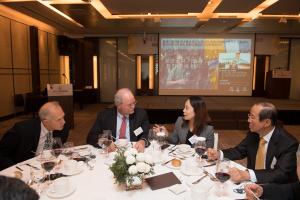More than four decades of partnership and a free trade agreement have benefitted agribusinesses in both the United States and South Korea. But the preservation of past success must be coupled with an innovative look at the future in order for that positive trading relationship to continue in years to come, South Korea customers told a delegation of leaders and staff from the U.S. Grains Council (USGC) and the National Corn Growers Association (NCGA) last week.
The joint mission visited with local cooperatives, a grocery store, a major port and a Korean farm using U.S. grains in addition to other activities. South Korea is a highly developed country with an equally highly developed food and feed market. The country has state of the art and efficient systems in place from slaughter plants to meat auctioning and more. However, similar to elsewhere in the world, feed consumption is expected to increase as per capita income continues to rise.
South Korean imports of feed grains in all forms reached 8.32 million metric tons in 2016/2017, including a six year-high for U.S. corn. South Korea also set a new record for imports of U.S. DDGS, as the country has done every year since 2010/2011. South Korea ranked as the third largest buyer of both commodities in 2016/2017.
The market access provisions in the United States-Korea Free Trade Agreement (KORUS) has positively contributed to South Korea’s rise to as a large and loyal buyer. The delegation discussed KORUS negotiations with customers and trade officials, including the Korean Trade Minister, who largely encouraged the preservation of current provisions in the agreement related to agriculture.
South Korea has existing free trade agreements with 52 countries and the government is actively looking at trade agreements with both MERCOSUR (South America’s trading bloc) and Russia, meaning the United States needs the market access provided by KORUS in order to remain competitive in this market.
“Our customers told us they have options too,” said Deb Keller, USGC chairman from Iowa. “The Council will maintain a strong presence in the South Korean market and work to keep communication lines open across feed, food and energy sectors.”
While in South Korea, USGC and NCGA officers and staff also assisted in a celebration marketing the 45th anniversary of the Council’s presence in South Korea.
“The 45th anniversary of the Council’s involvement in South Korea is significant for our customers and our members,” Keller said. “The celebration had good turnout from the Korean feed and livestock industries, who expressed great appreciation for the decades of partnership and desire for continued partnership in the years to come.”
As part of that future, the team discussed the future growth for U.S. ethanol. Current U.S. ethanol exports are for industrial use, meaning the Council is working to encourage wider use in the Korean transport fuel sector.
But, air pollution is a growing concern. South Korea is still relying on MTBE (methyl tertiary butyl ether) as an oxygenate, a substance displaced by ethanol in the United States due to MTBE’s potential health effects in drinking water. The team learned about the Council’s work to offer information on air quality improvement and greenhouse gas (GHG) emission reductions through blending ethanol.
“Air pollution is a growing concern in South Korea,” said Wesley Spurlock, NCGA chairman from Texas. “South Korea is paying close attention on how to reduce greenhouse gas emissions, providing an opportunity to discuss the environmental and economic benefits of U.S. ethanol.”
The delegation in South Korea included Keller; Spurlock; Lynn Chrisp, NCGA first vice president from Nebraska; Darren Armstrong, USGC secretary/treasurer from North Carolina; and Tom Sleight, USGC president and chief executive officer.
Learn more about the joint officers mission to South Korea here.


